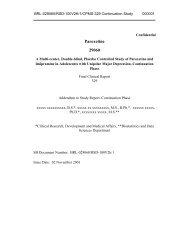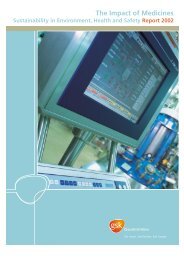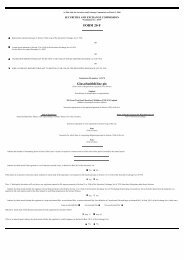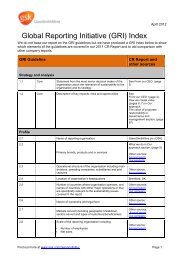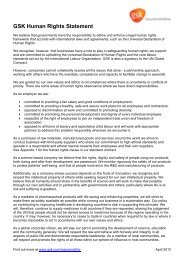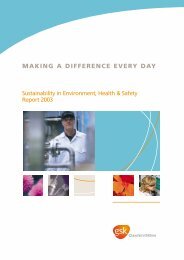GSK Annual Report 2002
GSK Annual Report 2002
GSK Annual Report 2002
Create successful ePaper yourself
Turn your PDF publications into a flip-book with our unique Google optimized e-Paper software.
124 GlaxoSmithKline Notes to the financial statements<br />
37 Reconciliation to US accounting principles continued<br />
Valuation of derivative instruments<br />
The fair value of derivative instruments is sensitive to movements in<br />
the underlying market rates and variables. The Group monitors the<br />
fair value of derivative instruments on a periodic basis. Derivatives<br />
including interest rate swaps and cross currency swaps are valued<br />
using standard valuation models, counterparty valuations, or thirdparty<br />
valuations. Standard valuation models used by the Group<br />
consider relevant discount rates, the market yield curve on the<br />
valuation date, forward currency exchange rates and counterparty<br />
risk. All significant rates and variables are obtained from market<br />
sources. All valuations are based on the remaining term to maturity<br />
of the instrument. Foreign exchange contracts are valued using<br />
forward rates observed from quoted prices in the relevant markets<br />
when possible. The Group assumes parties to long-term contracts<br />
are economically viable but reserves the right to exercise early<br />
termination rights if economically beneficial when such rights exist<br />
in the contract.<br />
Dividends<br />
Under UK GAAP, dividends proposed are provided for in the year in<br />
respect of which they are recommended by the Board of Directors<br />
for approval by the shareholders. Under US GAAP, such dividends<br />
are not provided for until declared by the Board of Directors.<br />
Deferred taxation<br />
Under UK GAAP the Group has implemented in <strong>2002</strong> FRS 19<br />
‘Deferred Tax’. This requires deferred tax to be accounted for on a<br />
full provision basis, similar to the requirement for US GAAP, rather<br />
than a partial provision basis as in 2001 and earlier years. As a<br />
consequence the Profit attributable to shareholders and Equity<br />
shareholders’ funds under UK GAAP and the deferred tax<br />
adjustments under US GAAP for prior periods have been restated.<br />
There is no impact to Net loss and Shareholders’ equity under US<br />
GAAP as previously reported. The adoption of FRS 19 has<br />
eliminated most of the differences for deferred tax that previously<br />
existed between UK GAAP and US GAAP. As a result, the<br />
adjustment now primarily relates to the deferred tax effect of other<br />
US GAAP adjustments.<br />
Exceptional items<br />
Items classified as exceptional under UK GAAP do not meet the<br />
definition of extraordinary under US GAAP and are therefore<br />
classified as operating expense.<br />
Consolidated statement of cash flows<br />
The US GAAP cash flow statement reports changes in cash and<br />
cash equivalents, which includes short-term highly liquid<br />
investments with original maturities of three months or less.<br />
Only three categories of cash flows are reported: operating<br />
activities (including tax and interest); investing activities (including<br />
capital expenditure, acquisitions and disposals together with<br />
cash flows from available for sale current asset investments);<br />
and financing activities (including dividends paid). A statement<br />
of cash flows is presented on page 128.<br />
Cash and cash equivalents<br />
Under UK GAAP the cash balance includes only cash at bank and<br />
other cash balances. Under US GAAP cash and cash equivalents<br />
include cash at bank and certain liquid investments with original<br />
maturities of three months or less.<br />
Comprehensive income statement<br />
The requirement of SFAS 130 ‘<strong>Report</strong>ing comprehensive income’ to<br />
provide a comprehensive income statement is met under UK GAAP<br />
by the Statement of total recognised gains and losses (pages 76 to<br />
77). A statement of comprehensive income under US GAAP for the<br />
three years in the period ending 31st December <strong>2002</strong> is presented<br />
on pages 126 and 127. Under US GAAP the statement includes the<br />
net impact of gains and losses on equity and liquid investments and<br />
translation adjustments.<br />
Recent Financial Accounting Standards Board (FASB)<br />
pronouncements<br />
In June 2001, the FASB approved SFAS 143 ‘Accounting for<br />
Obligations Associated with the Retirement of Long-Lived Assets’<br />
which requires that the fair values of the obligation associated<br />
with the retirement of long-lived assets be capitalised as part of<br />
the cost. This is required to be implemented by the Group with<br />
effect from 1st January 2003. The Group does not believe the<br />
adoption of this standard will have a material impact on its<br />
results.<br />
On 1st January <strong>2002</strong>, SFAS 144 ‘Accounting for the Impairment<br />
or Disposal of Long-Lived Assets’ was adopted by the Group.<br />
SFAS 144 develops one accounting model for long-lived assets,<br />
including discontinued operations to be disposed of by sale. It<br />
requires that all long-lived assets be measured at the lower of<br />
carrying amount or fair value less cost to sell whether reported in<br />
continuing or discontinued operations. The adoption of SFAS 144<br />
has not had a material impact on the Group’s financial<br />
statements.<br />
In April <strong>2002</strong>, SFAS 145 ‘Rescission of FASB Statements no. 4, 44<br />
and 64, Amendment of FASB Statement no. 13 and Technical<br />
Corrections’ was issued. The statement updates, clarifies and<br />
simplifies existing accounting standards. The Group does not<br />
believe the adoption of this standard will have a material impact<br />
on its results.<br />
SFAS 146 ‘Accounting for Costs Associated with Exit or Disposal<br />
Activities’, was issued in June <strong>2002</strong>. SFAS 146 requires companies<br />
to recognise costs associated with exit or disposal activities when<br />
they are incurred rather than at the date of a commitment to an<br />
exit or disposal plan and is to be applied prospectively to exit or<br />
disposal activities initiated after 31st December <strong>2002</strong>. The Group<br />
is currently assessing the impact of this standard.<br />
In November <strong>2002</strong>, the FASB published Interpretation no. 45,<br />
‘Guarantor’s Accounting and Disclosures requirements for<br />
Guarantees, Including Indirect Guarantees of Indebtedness of<br />
Others’ (FIN 45). FIN 45 expands on the accounting guidance of<br />
other SFASs. FIN 45’s provisions for initial recognition and<br />
measurement should be applied to guarantees issued or modified<br />
after 31st December <strong>2002</strong>. The disclosure requirements are effective<br />
for financial years ending after 15th December <strong>2002</strong>. The Group<br />
does not believe that the adoption of FIN 45 will have a material<br />
impact on its results.<br />
In January 2003, the FASB published Interpretation no. 46<br />
‘Consolidation of Variable Interest Entities’ (FIN 46). Under FIN 46<br />
the primary beneficiary of the entity must consolidate certain<br />
entities known as Variable Interest Entities. The measurement<br />
principles will apply to the Group’s 2003 Financial statements. The<br />
Group does not believe that the adoption of FIN 46 will have a<br />
material impact on its results.








